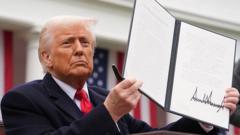In a notable development within international trade dynamics, President Donald Trump's assertive tariff tactics are beginning to yield results, with Japan emerging as a key player in this evolving landscape. Initially hesitant to seal a deal, Japan's negotiations have now reached a pivotal point, showcasing the potential effectiveness of Trump's aggressive trade policies.
The United States has championed the prospect of this deal, which could set a precedent for future agreements with other nations. Japan now finds itself with what can be considered the least unfavorable trade arrangement among major surplus countries with the U.S., as evidenced by the imposition of a 15% tariff on its goods—higher than the UK's 10% but with the latter lacking a significant trade surplus.
The tone of the discussions has shifted, with Japanese officials remarking on the sternness of their approach. The Japanese finance minister boldly referenced the nation's $1.1 trillion in U.S. Treasury bonds as leverage in the negotiations, stirring concerns within Washington circles accustomed to Japan's diplomatic decorum.
The implications of this deal stretch beyond Japan. It could serve as a catalyst for other global economies, such as the European Union, which had been contemplating coordinated responses against U.S. policies. With EU leaders present in Tokyo, this agreement sends a strong signal to potential allies about the diplomatic landscape shifting under the weight of tariffs.
Details of the agreement indicate that while Japan has safeguarded many agricultural imports, it has agreed to increase rice imports from the U.S., although the popularity of American automobiles remains uncertain. Nonetheless, Japanese companies are anticipated to invest heavily in U.S. infrastructure, which marks a significant reconciliation of interests amid these negotiations.
As the deal unfolds, it reveals a broader acceptance among allies of the tariffs that would have previously seemed improbable. Japan’s decision to engage now rather than wait out potential escalation reflects not only a strategic economic choice but also a response to internal pressures faced by its Prime Minister. Particularly in light of threats of heavier tariffs, Japan’s willingness to negotiate is indicative of a shifting economic landscape that involves calculated risks.
The financial ramifications of the trade war are becoming increasingly evident. Tariffs are substantially contributing to U.S. Treasury revenues, projected to reach $300 billion annually, constituting a notable portion of federal earnings. However, the burden of these tariffs ultimately falls on U.S. consumers, who are likely to face higher prices for imported goods.
Moreover, contrary to earlier expectations of currency stabilization benefitting import costs, the U.S. dollar has depreciated significantly, which complicates the economic picture further.
In conclusion, while the initial success of the U.S.-Japan trade agreement may deliver short-term optimism politically and within markets, the underlying complexities and uncertainties illustrate a much murkier economic outlook. Consequently, all eyes remain on the unfolding impacts of Trump's tariff strategies within the global context.

















